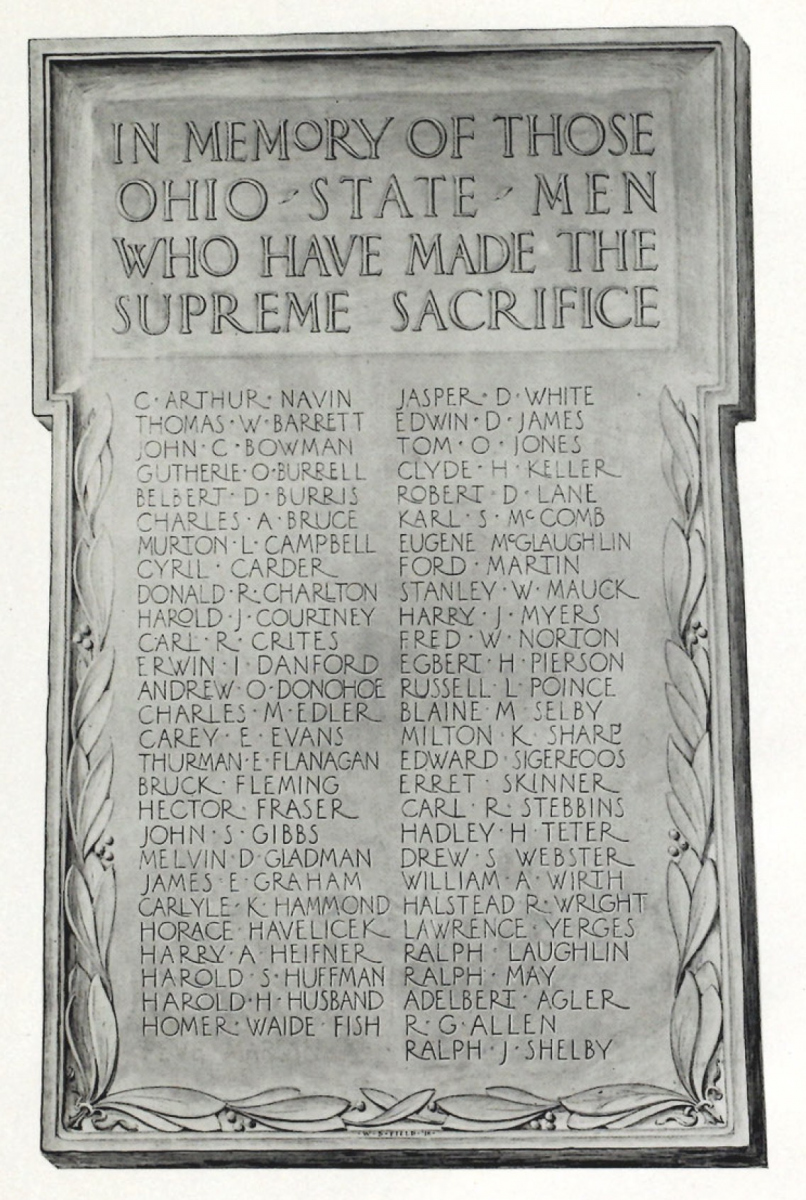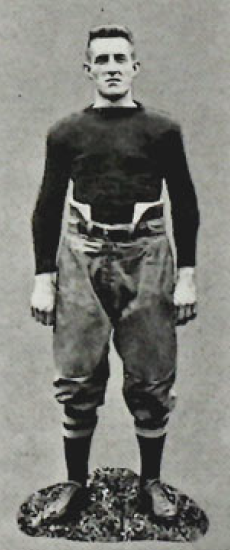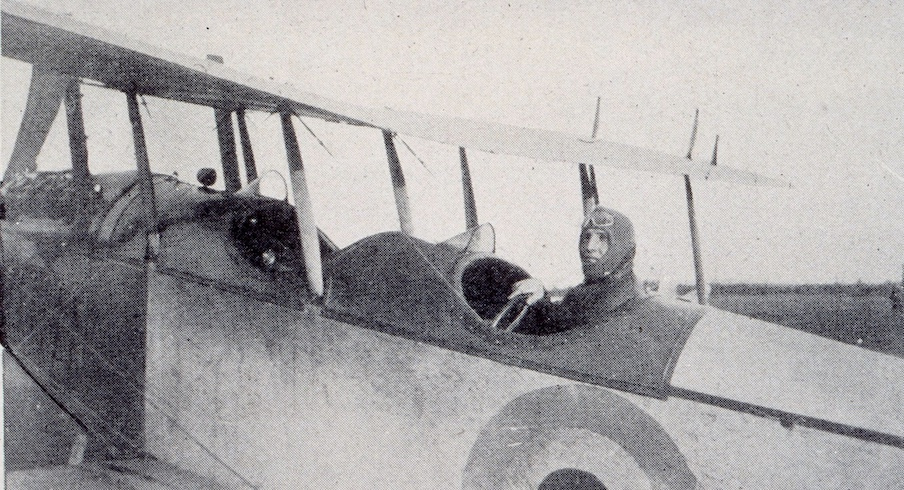On this Veterans Day, we take a look back at the legendary life of Fred Norton, a three-sport star for Ohio State who gave his life for his country in World War I.
In the fall of 1918, the large American flag that flew above University Hall was hardly ever raised to full mast because news of Ohio State students dying in the Great War reached campus nearly every other day. At 4:30 each afternoon, all activity ceased on the Oval as Orton Hall’s bells pealed out “Carmen Ohio.” As the last notes of the alma mater echoed away, a lone bugler filled the air with the haunting notes of “Taps.”
The time was chosen to align with the time that taps was played each evening for the American warriors in the trenches of Europe.
After the Armistice, this solemn ritual continued as a weekly event until 1963. Today the playing of taps is part of the Memorial Rock Ceremony held annually during Veterans Day weekend. A large boulder lies in front of Bricker Hall with a plaque affixed to it that honors Ohio State students who answered the call of duty during World War I.

Over 6,500 students, alumni and staff connected to Ohio State joined the service. This figure didn’t include the pilots and balloon officers trained in the School of Military Aeronautics housed on campus, nor any of the specialized coursework and training seminars created specifically to feed, both metaphorically and practically, a great nation engaged in all-out war. Official figures were never tallied of people associated with Ohio State to account for the countless hours volunteered on activities as wide-ranging as wrapping bandages or knitting socks to the buying and selling of Liberty and Victory bonds.
The former Ohio State students who lost their lives included two football players. One was a former All-Conference tackle and captain of the 1917 team named Harold “Hap” Courtney. Hap entered the Naval Reserves in early 1918 and trained at the Naval Training School in Great Lakes, Illinois. He died of pneumonia on the Atlantic Ocean aboard the USS Louisville on September 21, 1918.
The other was Frederick William Norton, the first Ohio State athlete to die in the war. Norton wasn’t just any athlete, he was a three-sport star who was a three-year letterman in baseball, basketball and football. At the time of his death, it was predicted that history would recognize him as “one of [Ohio State’s] most outstanding athletes of all time.”
Norton excelled in the classroom as a student in the College of Agriculture studying forestry. He was a member of Ohio State’s two oldest honor societies, Bucket & Dipper and Sphinx.
“Nortie” was a slick-fielding shortstop for some very good Ohio State baseball teams. The Buckeyes were a combined 27-3 his junior and senior seasons and claimed the Western Conference championship in 1917. As a senior, he batted .442. scored 25 runs in 15 games and received the ”Runmaker’s Cup” as the team’s best player.
He ran afoul of basketball coach Lynn St. John, who slapped Nortie with a one-game suspension as a junior for the “rather flagrant violation” of attending a dance. Said St. John, “A man is not supposed to go to a dance on the night before a game. So far as I know, there have been no other violations of training, but it must be broken up!”
Fred served as captain of the 1916-17 squad that finished 15-11. The 1917 yearbook said “Captain Norton played the best game, guarding well and scoring 36 goals to his opponents 11 in the Western Conference.”
Norton, who was 5-foot-9 and 155 pounds, had never played football before coach John Wilce tapped him to play quarterback as a sophomore in 1914. Despite his lack of experience, Wilce recognized and trusted Norton’s leadership and talents. When the starting quarterback was injured early in a game against Case, Wilce turned to Norton. Wilce's trust paid off as Norton led Ohio State to a critical 7-6 road victory.

The 1915 season produced Ohio State’s first winning conference record, but the highlight of the season was the stunning 3-3 draw against a powerful Illinois team. Illinois was the defending conference champion and had not been beaten in two seasons. Ohio State also topped Northwestern and Indiana that year to post its first winning record in the Western Conference. Norton was the hero of the Indiana game as he caught a long touchdown pass to give the Buckeyes a 10-9 come-from-behind victory.
If the 1915 season served to validate that the Buckeyes were no longer “the Babes of the Western Conference,” the arrival of Chic Harley in 1916 put them on par with any team in the country. As the starting halfback opposite Harley, Norton proved to be a valuable runner and receiver as well as a crisp blocker. In a 128-0 blowout of Oberlin, Norton scored five touchdowns on just six carries; against Indiana, he had a 53-yard kickoff return and a 26-yard touchdown run.
Norton played a critical role in Ohio State’s history-making drive against Illinois in 1916. On fourth down with time running out, Norton caught a Harley pass for a drive-saving first down. Harley scored a few plays later to tie the score 6-6. Norton then caught the all-important kick-out which was a part of the point-after process in those days. The kick-out determined the spot of the extra point, or if the kick out of the end zone fell incomplete there would be no point after try. Norton caught it and Harley made the PAT. Ohio State beat Illinois, 7-6, and changed the course of Buckeye football forever.
Norton received his initial aviator training at the Royal Flying Corps School in Toronto, Canada. After a stop in Texas, he was sent overseas in early 1918. Fred was in France as part of the 27th Aero Squadron. Columbus-born racing legend Eddie Rickenbacker was among the pilots Norton trained with.
Norton was a natural flier who delighted in aerial acrobatics. In a letter to an Ohio State friend, he told about a mechanic who begged Norton to take him for a ride. Norton wrote:
“I went up about 4,500 feet, shut off my engine and put her into a spinning nose drive. The only thing one can see is a small circle of ground. The rest goes by like a flash. I pulled her out at 3,000 feet and before the mechanic really recovered, I looped and instead of going over clean I fell through. Consequently we were forced to hang in our belts. After coming out of that I stalled by nosing her straight up until she stopped, then falling tail first for a while and finally falling over with a rush. When I leveled out I was 1500 feet in the air. I then nosed her straight down and landed.”
The series of loops and spins produced a woozy mechanic who was in no rush to leave the ground again.
Stunt flying was an important component in aerial battles of World War I and also made great copy for newspapers back home. A wire service story in July 1918 told of 1st Lt. Norton’s role in leading a large American formation in a “THRILLING AIR RAID” over German lines in the Toul sector of France. Norton’s squadron engaged a formation of nine “German aces.” Although both machine guns on Norton’s plane jammed, Fred stayed with his formation despite being targeted four separate times. At one point Norton placed himself in peril, flying between two attacking German planes to create a window for an American aviator to escape. Every American returned from the battle and the German planes were destroyed in the dogfight.
Tragically, Norton’s final flight would be just a few weeks later. On July 20, 1918, while strafing near entrenched German positions, he was struck by a bullet in the chest and another in his back. He was able to land his plane but was stranded in no-man's-land and it took two days for medics to get to him. He died soon after arriving at a French hospital.
Rickenbacker, who became America's most famous WWI Ace, asserted to a Columbus audience in 1919 that Norton, “had he lived through the terrifically hard fighting” he faced, would have become “the foremost airman in America.”
Fred W. Norton was awarded the Distinguished Service Cross and the French Croix de Guerre with Palm for the extraordinary heroism he showed in battle. He was buried in L’Angres France, but his spirit lived on back home even though his body never returned. The city of Columbus named its first airfield, Norton Field, in recognition of his bravery.
Norton was inducted into the Ohio State Athletics Hall of Fame in 2010.
You can learn more about the early years of Ohio State football in the author’s book “Days of Yore: The Men of Scarlet and Gray,” which is available for purchase on Amazon. You can follow McQuigg on Twitter @dpmcquigg.


